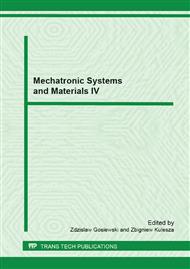[1]
S. Ochelski and others, Influence of hardness on mechanical properties of elastomers, Journal of KONES, 17 317-325.
Google Scholar
[2]
A. Krawczyk and others, Mechanics of polymer and composite materials, Science (1985).
Google Scholar
[3]
C. M. Roland, Mechanical behaviour of rubber at high strain rates, Rubber Chemistry and Technology, 79 (2006) 429-459.
DOI: 10.5254/1.3547945
Google Scholar
[4]
W. Chen, F. Lu, D. J. Frew, M. J. Forrestal, Dynamic compressive testing of soft materials, Journal of Applied Mechanics, 69 (2002) 214–223.
DOI: 10.1115/1.1464871
Google Scholar
[5]
S. J. Quintavalla, S. H. Johnson, Extension of the Bergstrom–Boyce model to high strain rates, Rubber Chemistry and Technology, 77 (2005) 972–981.
DOI: 10.5254/1.3547863
Google Scholar
[6]
P. A . Du Bois, S. Kolling, S. Fassnacht, Material modeling with LS-DYNA for crashworthiness analysis, LS-Dyna forum, Germany, 2: 1-56 (2002).
Google Scholar
[7]
Y. Chen and others, Crash dynamics of square honeycomb thin rubber wall, Thin-Walled Structures, 47 (2009) 1447-1456.
DOI: 10.1016/j.tws.2009.07.007
Google Scholar
[8]
P. A . Du Bois, S. Kolling, S. Fassnacht, Material behaviour of polymers under impact loading, International Journal of Impact Engineering, 32 (2006) 725-740.
DOI: 10.1016/j.ijimpeng.2005.02.007
Google Scholar
[9]
M. S. Hoo Fat, I. Bekar, High-speed testing and material modelling of unfilled styrene butadiene vulcanizates at impact rates, Journal of Materials Science, 39 (2004) 6885–6899.
DOI: 10.1023/b:jmsc.0000047530.86758.b9
Google Scholar
[10]
I. Bekar, M. S. Hoo Fatt, J. Padovan, Deformation and fracture of rubber under tensile impact loading, Tire Science Technology, 30 (2002) 45.
DOI: 10.2346/1.2135247
Google Scholar
[11]
N. S. Al-Maliky, D. J. Parry, A freely expanding ring technique for measuring the tensile properties of polymers, Materials Science Technology, 7 (1996) 746-752.
DOI: 10.1088/0957-0233/7/5/004
Google Scholar
[12]
W. H. Gourdin, S. L. Weinland, R. M. Boling, Development of the electromagnetically launched expanding ring as a high-strain-rate test technique, Review of Scientific Instruments, 60, (1989) 427-432.
DOI: 10.1063/1.1140395
Google Scholar
[13]
P. Kainradl, F. Händler, Heat Build-Up and Destruction of Vulcanizates under Dynamic Stress, 33 (1960) 1438.
Google Scholar
[14]
L. Kruszka, Badania eksperymentalne własności statycznych i dynamicznych stali budowlanych dla potrzeb konstrukcji ochronnych i obronnych, Seminar Materials of Military University of Technology (2008).
Google Scholar
[15]
ANSYS, Hyperelasticity, Structural Nonlinearities, 6 (1999) Second Edition Release 5. 5.
Google Scholar
[16]
M. Mooney, A theorie of elastic deformations, Journal of Application Physics, 11 (1940) 582-592.
Google Scholar
[17]
R. S. Rivlin, Large elastic deformations of isotropic materials, Fundamental Concepts, Philos Trans R Soc Land Ser A, 240 (1948) 459-490.
DOI: 10.1098/rsta.1948.0002
Google Scholar
[18]
J.O. Hallquist, LS-Dyna: Theoretical manual, California Livermore Software Technology Corporation (2003).
Google Scholar
[19]
D.J. Benson, S. Kolling, P.A. Du Bois, A simplified approach for strain-rate dependent hyperelastic materials with damage, 9-th International LS-DYNA Users Conference, 15 (2006) 29-36.
Google Scholar
[20]
R.W. Ogden, Elastic deformations of rubberlike solids, Mechanics of Solids, The Rodney Hill 60th Anniversary Volume, Oxford (1982).
DOI: 10.1016/b978-0-08-025443-2.50021-5
Google Scholar
[21]
P. Baranowski, J. Małachowski, Blast wave and suspension system interaction- numerical approach, Journal of KONES, 18: 1 (2011) 23-30.
Google Scholar
[22]
P. Baranowski, J. Małachowski, T. Niezgoda, Numerical analysis of vehicle suspension system response subjected to blast wave, Applied Mechanics and Materials, 82 (2011) 728-733.
DOI: 10.4028/www.scientific.net/amm.82.728
Google Scholar


